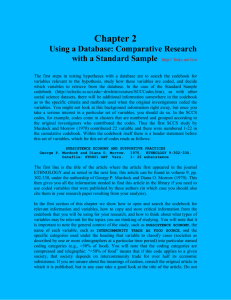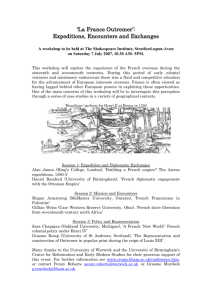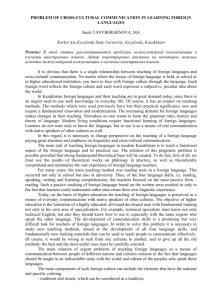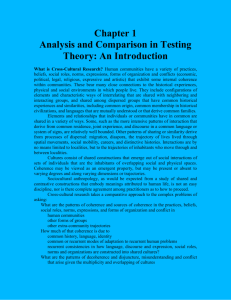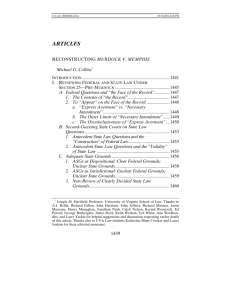SCCSencycl
advertisement
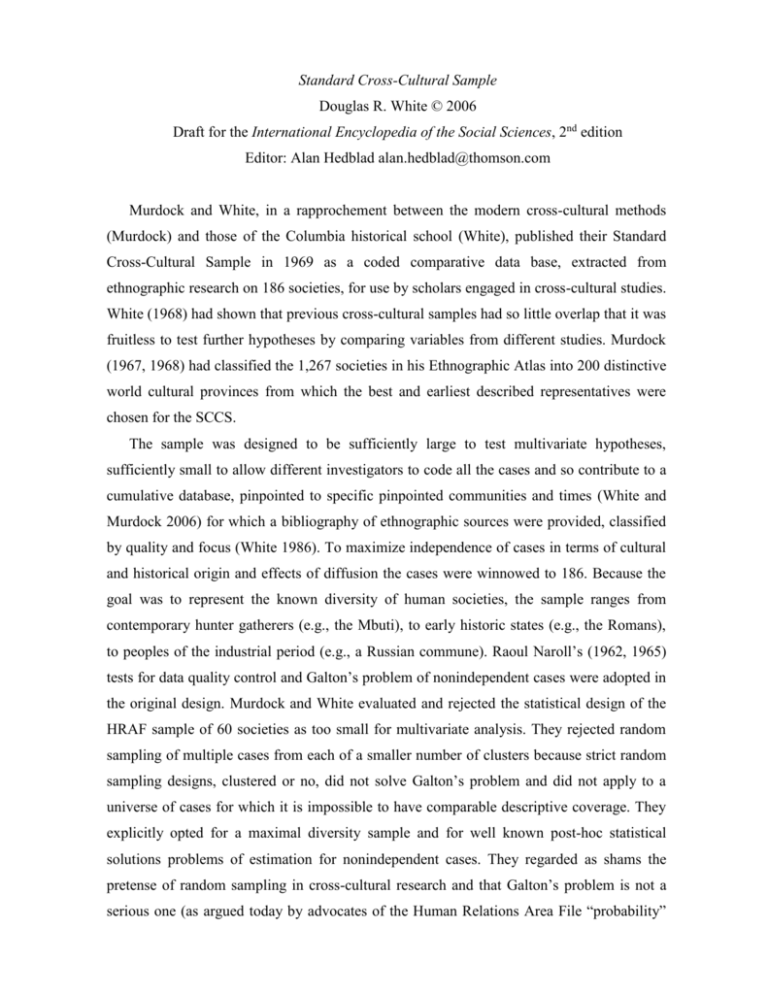
Standard Cross-Cultural Sample Douglas R. White © 2006 Draft for the International Encyclopedia of the Social Sciences, 2nd edition Editor: Alan Hedblad alan.hedblad@thomson.com Murdock and White, in a rapprochement between the modern cross-cultural methods (Murdock) and those of the Columbia historical school (White), published their Standard Cross-Cultural Sample in 1969 as a coded comparative data base, extracted from ethnographic research on 186 societies, for use by scholars engaged in cross-cultural studies. White (1968) had shown that previous cross-cultural samples had so little overlap that it was fruitless to test further hypotheses by comparing variables from different studies. Murdock (1967, 1968) had classified the 1,267 societies in his Ethnographic Atlas into 200 distinctive world cultural provinces from which the best and earliest described representatives were chosen for the SCCS. The sample was designed to be sufficiently large to test multivariate hypotheses, sufficiently small to allow different investigators to code all the cases and so contribute to a cumulative database, pinpointed to specific pinpointed communities and times (White and Murdock 2006) for which a bibliography of ethnographic sources were provided, classified by quality and focus (White 1986). To maximize independence of cases in terms of cultural and historical origin and effects of diffusion the cases were winnowed to 186. Because the goal was to represent the known diversity of human societies, the sample ranges from contemporary hunter gatherers (e.g., the Mbuti), to early historic states (e.g., the Romans), to peoples of the industrial period (e.g., a Russian commune). Raoul Naroll’s (1962, 1965) tests for data quality control and Galton’s problem of nonindependent cases were adopted in the original design. Murdock and White evaluated and rejected the statistical design of the HRAF sample of 60 societies as too small for multivariate analysis. They rejected random sampling of multiple cases from each of a smaller number of clusters because strict random sampling designs, clustered or no, did not solve Galton’s problem and did not apply to a universe of cases for which it is impossible to have comparable descriptive coverage. They explicitly opted for a maximal diversity sample and for well known post-hoc statistical solutions problems of estimation for nonindependent cases. They regarded as shams the pretense of random sampling in cross-cultural research and that Galton’s problem is not a serious one (as argued today by advocates of the Human Relations Area File “probability” sample – the textual ethnographic resources, research collections and publications may be useful for many things, but sampling and statistics has not been their forte). Murdock and White provided in their sample standard Galton's problem controls for historical nonindependence of cases, and for adjusting significance tests and estimates of variance accordingly. Distancing themselves from HRAF, all of the cross-cultural articles and data published in the journal Ethnology, and all the bibliographic, pinpointing and coded data sets (except for those published by HRAF) have been contributed to the public scientific domain. The journal World Cultures, edited by White from 1985-1990 has continued to publish SCCS cross-cultural codes and analytical articles. As of 2006, the following is a list of author and dates for publications containing coded data, up to 2002 variables, for the Standard Cross-Cultural Sample, ordered chronologically as to when the variables were added to the cumulative database and codebook: (1), Murdock and Morrow 1970 (2), Barry and Paxson 1971 (3), Murdock and Wilson 1972 (4), Tuden and Marshall 1972 (5-6), Murdock and Provost 1973 (7), Broude and Greene 1976 (8), Whiting (unpublished) (9-12), Murdock 1967 (13) Barry, Josephson, Lauer, and Marshall 1976 (14-18), Barry, Josephson, Lauer, and Marshall 1977 (19-20), Ronald Rohner and Rohner 1982 (21), Alice Schlegel and Barry 1979 (22), Karen Paige and Paige 1981 (23-25), Martin Whyte 1978 (25), Murdock 1970 (26), Peggy Sanday 1981 (27-28), Whyte (unpublished) (29), Broude and Greene 1983 (30), Marc Ross 1983 (31), Ronald Rohner, Berg and Rohner 1982 (32), Barry and Schlegel 1982 (33), Schlegel and Barry 1984 (34), White and Murdock 1969 (35), White, Whiting and Burton (unpublished) (37), White 1988 (38), Winkelman and White 1986 (39), White (unpublished) (40), Wheeler 1974 (41), Orlando Patterson 1982 (42), Pryor 1986 (43-45), Frayser 1985 (46), Rohner and Rohner 1982 (47-52), White and Burton (unpublished) (53), White (unpublished) (54), Pryor 1984 (55), Murdock 1957 (56-59), Laura Betzig 1986 (60), Roberts 1976 (61), Murdock and White (unpublished) (62), Murdock 1970 (62a), White & Murdock (63), Anderson, Crawford, Nadeau and Lindberg 1992 (64), Low 1988 (65), Dirks 1993 (6677), Bradley 1987 (78), Ember & Ember 1992 (79), Ludovico 1955 (80), Divale, Abrams, Barzola, Harris, and Henry 1998 (81-82), Lang & Schweizer 1998 (83-84), Divale & Seda 1999 (85), Schroeder 2001 (86), Burton 1999 (87), Divale 1999 (88-90), Cashdan 2001 (91) Koratayev and Khaltourina. Although the SCCS is not suited to drawing conclusions about contemporary societies (see cross-national studies) but is about much of the known range of cultural variability in human societies up to 1950, hundreds of cross-cultural studies have contributed new codes for the pinpointed societies in the SCCS. Those resulting from Murdock and White’s NSF research project are published in Barry and Schlegel (1980). Thousands of authors have used these data for research in virtually every area in which cross-ethnographic comparisons are useful in many subdisciplines of the social and other sciences. One way to evaluate the impact of findings using the SCCS is to look at a few of the books that treat their subject comprehensively in which the authors added coded data on their specialties. These studies illustrate how the SCCS is sufficiently large to test multivariate hypotheses. Sociologist Orlando Patterson (1982), for example, carries out a magisterial study of the internal dynamics of slavery using the sixty-six slave societies of the SCCS based on his own codings of slavery variables. This is a first of its kind study on the nature of slavery over time, world and historical-comparative: tribal, ancient, premodern, and modern, concluding “Slavery is shown to be a parasitic relationship between master and slave, invariably entailing the violent domination of a natally alienated, or socially dead, person.” The internal dynamics of slavery is shown to be “a single process of recruitment, incorporation on the margin of society, and eventual manumission or death.” Economist Fred Pryor (2005a) carries out a similar program of research in his SCCS comparative study of world economic systems. In his article (2005b) on the 41 agricultural societies in the SCCS, using clustering analysis of variables covering the full range of variation in production, property, and distribution, he finds evidence for only four basic agricultural systems among 36 clusterable cases (with 5 unclusterable): herding plus, egalitarian farming, individualized, and semimarketized farming. Although “many anthropologists and historians consider agricultural systems to be the outcome of environmental, social, social-structural, and political variables, a statistical analysis indicates that very few such variables are correlated with the derived economic systems. The systems are thus revealed to stand as independent entities and worthy of more intensive study. Anthropologist and Islamic specialist Andrey Korotayev (2004) is the first to code world region for SCCS findings, and his analyses result in a fertile set of findings. One of the most powerful is that world religion is the best predictor of large regional similarities in social structure, and that the boundaries of many of the major types of social structure (like Pryor, using cluster analysis on the relevant variables) closely such boundaries as the extent of the 8th century caliphates resulting from the Arab/Islamic expansion. Paige and Paige (1981) succeed in identifying systemic patterns in their study of gender roles by restricting their study to the 108 pre-state societies in the SCCS and focusing their hypotheses on three levels of resources: low-value, unstable, and stable. They then develop contrastive hypotheses about how resource levels affect women and the interests of men either in identification with females, or in surveillance over female reproduction. With low material resources, females are both food producers and are highly valued for the reproduction of children who add labor and enlarge the group and its prestige. With stable resources, property and inheritance becomes and issue and children’s paternity becomes an issue for men as regards women. Their results show highly coherent results as regards their theory of the politics of reproductive issues and affect social organization more generally. Evolutionary biologist Laura Betzig (1986) focuses on the starkest of Darwinian issues, power and the differential extremes of open or sub-rosa control over female reproduction in harems, concubines, and mistresses, as documented by her coding of the 186 cases in the SCCS. Like Paige and Paige, she sees men in societies with property as essentially concerned with the fidelity of their wives, but goes further to explore the vicious circle of links between differences in power and differences in reproductive success that are virtually without limit for powerful males. Controversial and starkly sociobiological, her explanation as to why modern states become less despotic is that to attract mercenaries, specialists in defense, craftsmen, and those who run the state, people in power are been forced to make concessions to others who still serve, directly or indirectly, to contribute to the reproductive efforts of men in power. Her philosophical predilection is to reject theories of further checks and balances in favor of a modernist extreme: that the powerful dictate the laws in their own (reproductive) interests even in the absence of absolutist despotism. Sanday (1981) rejects the argument of universal female subordination, and after coding variables that contribute to different measures of relative male domination and female power, argues that male dominance is not inherent in human relations but is socially constructed through behavioral and symbolic mechanisms which institute male dominance, which stands in contrast to a people's secular power roles. The latter, she argues, derive partly from ancient concepts of power, as exemplified by their origin myths. Her hypotheses test the extent to which female power and male dominance are further determined by a people's adaptation to their environment, social conflict, and emotional stress. She illustrates here thesis through case studies of the effects of European colonialism, migration, and food stress, and supported by numerous statistical associations between sexual inequity and various cultural stresses. Sanday and Betzig strike the reader as having made up their mind what theory they are going to test, and hoping for a certain answer, before they began, but they contribute coded data and statistical hypothesis tests that can be revised and challenged by others, using the cumulative data from the SCCS. Patterson, Pryor, and Korotayev are more intent on coding variables that reflect the range of variability in the phenomena they study, and working more inductively from their findings, guided by theoretical questions. Whyte (1978) reflects the extreme inductive approach, coding half the SCCS societies for each of hundreds of genderrelated variables that have been used in previous studies of gender roles. Whyte summarizes his findings on male dominance, noting “our variables have divergent cross-cultural distributions. Some, such as items for political leadership, are highly skewed in favor of men; others, such as property inheritance …, are more moderately skewed toward men; still others, such as the elaborateness of funerals or final authority over infants, flow little or no male bias cross-culturally… [Further], these different indicators are not associated with each other….” [and] “there are some things that have been assumed in the … literature to have status implications for women may not.” [There are] “no grounds for assuming that the relative subsistence contribution of women has any general status implications.” (p. 169) Whyte is somewhat critical in this regard of Sanday’s results. Google Scholar cites 414 on-line citations to articles referencing the SCCS as of 2006 and there are perhaps four to six times that number not referenced. They address a huge variety of topics. Their diversity, and their common references to a framework of variables and sample cases, along with the agreements and relatively clear bases for disagreements among authors can be taken as indicators of success in the design of the SCCS. Cross-cultural research entails a statistical problem – known as Galton's problem – that is endemic to nonexperimental research: tests of functional relationships are confounded with diffusion (cross-cultural borrowing) and historical origin or path dependency (e.g., descent from a common cultural ancestor). Paige and Paige and Pryor are examples from those above who address this problem, as to Murdock and White (1969). Problems of statistical inference, however, must be the subject of separate discussion. Betzig, Laura. 1986. Despotism and Differential Reproduction: A Darwinian View of History. New York: Aldine. Frayser, Suzanne G. 1985. Varieties of Sexual Experience. HRAF Press. Korotayev, Andrey. 2004. World Religions and Social Evolution of the Old World Oikumene Civilizations: A Cross-cultural Perspective. Lewiston, NY: Edwin Mellen Press. Murdock, G. P. 1980. Theories of Illness: A World Survey. Pittsburgh: University of Pittsburgh Press. Paige, Karen Paige and Jeffrey Paige. 1981. The Politics of Reproductive Ritual. University of California Press. Patterson, Orlando. 1982. Slavery and Social Death: A Comparative Study. Cambridge, Mass. Harvard University Press. Pryor, Frederick L. (2005a). Economic systems of foraging, agriculture, and industrial societies. New York: Cambridge University Press. (2005b) Rethinking Economic Systems: A Study of Agricultural Societies. Cross-Cultural Research 39(3):252-292. http://ccr.sagepub.com/cgi/content/abstract/39/3/252 Sanday, Peggy. 1981. Female Power and Male Dominance: On the Origins of Sexual Inequality. New York: Cambridge University Press. Wheeler [Nammour],Valerie. l974. Drums and Guns: A Cross-Cultural Study of the Nature of War. Ph. D. Dissertation, University of Oregon. Whyte, Martin K. 1978. The Status of Women in Preindustrial Societies. Princeton University Press. *** Barry, Herbert, III, and Alice Schlegel. (1980). Cross-Cultural Samples and Codes. Pittsburgh: University of Pittsburgh Press. Murdock, George Peter. 1967. Ethnographic Atlas. Pittsburgh: University of Pittsburgh Press. Murdock, George Peter. 1968. World Sampling Provinces. Ethnology 7:305-326. Murdock, George Peter and Douglas R. White. 1969. Standard Cross-Cultural Sample. Ethnology 9:329-369. http://repositories.cdlib.org/imbs/socdyn/wp/Standard_Cross-Cultural_Sample Naroll, Raoul. 1962. Data Quality Control: A New Research Technique. Glencoe. Ill.: The Free Press. 1965. "Galton's problem: The logic of cross cultural analysis." Social Research. 32: 428-51. White, Douglas R. 1968 "Societal Research Archives System: Retrieval, Quality Control and Analysis of Comparative Data." Social Science Information 7(3): 78-94. White, Douglas R. 1986. Focused Ethnographic Bibliography for the Standard CrossCultural Sample. World Cultures 2(1):1-126. White, Douglas R. and George P. Murdock. 2006: Pinpointing Sheets for the Standard Cross-Cultural Sample. http://eclectic.ss.uci.edu/~drwhite/xc/SCCSPinpointing.html


